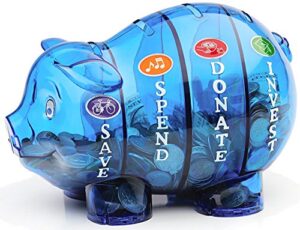Teaching kids to manage their money has become an increasingly discussed topic. Most of us have some kind of allowance system for our children, but have we taught them how to manage that money? Do they save all of their money and spend rarely, or do they spend it all as soon as they receive it?
Setting some simple expectations with our kids can help them right from the beginning of their allowance time, but even if you are several years into this, you can implement a simple system to help your kids build habits to manage their money wisely.
 Where to start
Where to start
Most money management systems for kids recommend that you set up three categories for them to divide their money into. These vary a bit, but generally settle on at least spending, saving, and giving. Investing is another category you can use or add later. You and your child can decide together what percentage of their allowance or other money should go into each category. For example, most of my kids pool together to buy a birthday gift for a sibling, but I have one child who wants nothing to do with this. She loves to buy her siblings really nice gifts just from her. So she needs to set aside more in her giving category than my other children.
How do you keep track of what is in each category? 
You can get a fancy piggy bank with divided sections labelled with SAVE and SPEND, or you can use any containers you’d like to use. You could keep the money in one piggy bank and keep a notebook or a digital record of your category totals. Figure out what would really work for you and your child.
As you teach about money and how much goes into each category, you can work on your number signs. You can find lots of number signs here in our dictionary.
What about a savings account?
It’s recommended for young children to begin with actual money to help them with the general concept of using money. Young children think concretely, so making money use a concrete thing will cement the concepts in their minds. As they grow older and can handle more abstract and out of sight thinking, a savings account is great for them. They can learn about interest and long term savings goals. And really, by this point, they’ll need somewhere more secure to keep their savings anyway.
Giving
Even for children, it’s important to teach giving, and it’s important to plan for giving. Whether your family donates to a specific organization or participates in other causes, helping others is a good habit to develop. There are the annual gift giving holidays and traditions to save for as well. Gift-giving is way more fun when you have a clear and adequate amount to spend.
Of course, giving is not limited to money. Giving of our time and effort is just as important, and that can also be taught here. If your child has a strong interest, see if there is a charity to support within that interest.
It’s always important to learn to help others in some way, and as you teach this concept you can use the sign for help. I’m going to teach my kids this one!
Spending
We can teach our kids to compare prices and values by our own everyday habits. Let your kids look at the sales circulars with you as you make your grocery list. When they want to know why you’re standing in front of the mustard for so long, explain what you are comparing, and show them how you can check the unit prices. And when they are ready to make a purchase of their own, show them how to check different websites for different prices, how to read reviews, and how to find the lowest price for the best value.
As you teach good spending habits, you can use the signs for buy and store.
Credit
Financial planning institutions encourage parents to teach kids about credit and to use it in a healthy way. When your child wants to buy a higher ticket item, you can give them a choice. He can save up and wait to buy it until he has enough money, or you can loan him the money with an interest plan and a due date. This teaches two valuable skills – waiting and planning. It’s also a safe way to practice using credit before real life credit use.
We can teach our kids to manage their money wisely and well. What system do you use in your home?
Remember, you can always access our full content from anywhere with a MySigningTime digital subscription. Try it with a 14-day free trial here!

